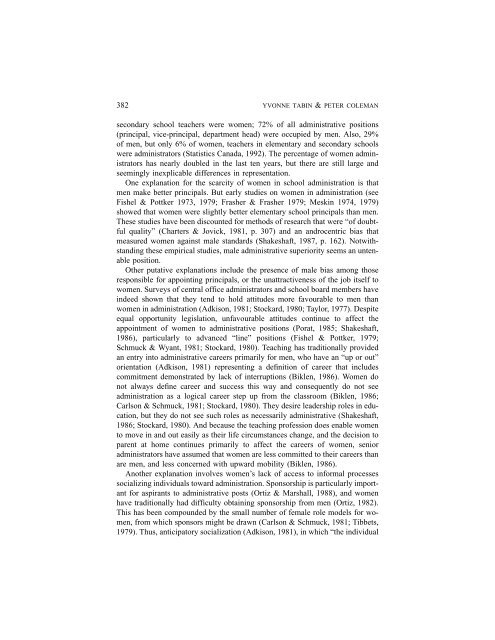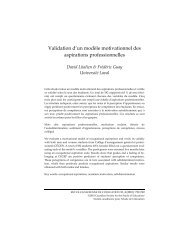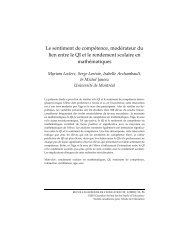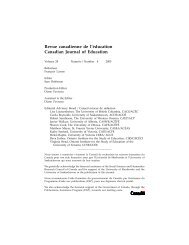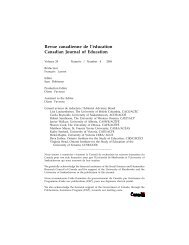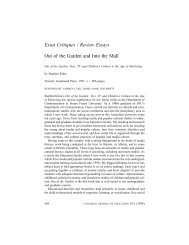Mireille Falardeau et Michel Loranger Le choix de stratégies ... - CSSE
Mireille Falardeau et Michel Loranger Le choix de stratégies ... - CSSE
Mireille Falardeau et Michel Loranger Le choix de stratégies ... - CSSE
You also want an ePaper? Increase the reach of your titles
YUMPU automatically turns print PDFs into web optimized ePapers that Google loves.
382 YVONNE TABIN & PETER COLEMAN<br />
secondary school teachers were women; 72% of all administrative positions<br />
(principal, vice-principal, <strong>de</strong>partment head) were occupied by men. Also, 29%<br />
of men, but only 6% of women, teachers in elementary and secondary schools<br />
were administrators (Statistics Canada, 1992). The percentage of women administrators<br />
has nearly doubled in the last ten years, but there are still large and<br />
seemingly inexplicable differences in representation.<br />
One explanation for the scarcity of women in school administration is that<br />
men make b<strong>et</strong>ter principals. But early studies on women in administration (see<br />
Fishel & Pottker 1973, 1979; Frasher & Frasher 1979; Meskin 1974, 1979)<br />
showed that women were slightly b<strong>et</strong>ter elementary school principals than men.<br />
These studies have been discounted for m<strong>et</strong>hods of research that were “of doubtful<br />
quality” (Charters & Jovick, 1981, p. 307) and an androcentric bias that<br />
measured women against male standards (Shakeshaft, 1987, p. 162). Notwithstanding<br />
these empirical studies, male administrative superiority seems an untenable<br />
position.<br />
Other putative explanations inclu<strong>de</strong> the presence of male bias among those<br />
responsible for appointing principals, or the unattractiveness of the job itself to<br />
women. Surveys of central office administrators and school board members have<br />
in<strong>de</strong>ed shown that they tend to hold attitu<strong>de</strong>s more favourable to men than<br />
women in administration (Adkison, 1981; Stockard, 1980; Taylor, 1977). Despite<br />
equal opportunity legislation, unfavourable attitu<strong>de</strong>s continue to affect the<br />
appointment of women to administrative positions (Porat, 1985; Shakeshaft,<br />
1986), particularly to advanced “line” positions (Fishel & Pottker, 1979;<br />
Schmuck & Wyant, 1981; Stockard, 1980). Teaching has traditionally provi<strong>de</strong>d<br />
an entry into administrative careers primarily for men, who have an “up or out”<br />
orientation (Adkison, 1981) representing a <strong>de</strong>finition of career that inclu<strong>de</strong>s<br />
commitment <strong>de</strong>monstrated by lack of interruptions (Biklen, 1986). Women do<br />
not always <strong>de</strong>fine career and success this way and consequently do not see<br />
administration as a logical career step up from the classroom (Biklen, 1986;<br />
Carlson & Schmuck, 1981; Stockard, 1980). They <strong>de</strong>sire lea<strong>de</strong>rship roles in education,<br />
but they do not see such roles as necessarily administrative (Shakeshaft,<br />
1986; Stockard, 1980). And because the teaching profession does enable women<br />
to move in and out easily as their life circumstances change, and the <strong>de</strong>cision to<br />
parent at home continues primarily to affect the careers of women, senior<br />
administrators have assumed that women are less committed to their careers than<br />
are men, and less concerned with upward mobility (Biklen, 1986).<br />
Another explanation involves women’s lack of access to informal processes<br />
socializing individuals toward administration. Sponsorship is particularly important<br />
for aspirants to administrative posts (Ortiz & Marshall, 1988), and women<br />
have traditionally had difficulty obtaining sponsorship from men (Ortiz, 1982).<br />
This has been compoun<strong>de</strong>d by the small number of female role mo<strong>de</strong>ls for women,<br />
from which sponsors might be drawn (Carlson & Schmuck, 1981; Tibb<strong>et</strong>s,<br />
1979). Thus, anticipatory socialization (Adkison, 1981), in which “the individual


